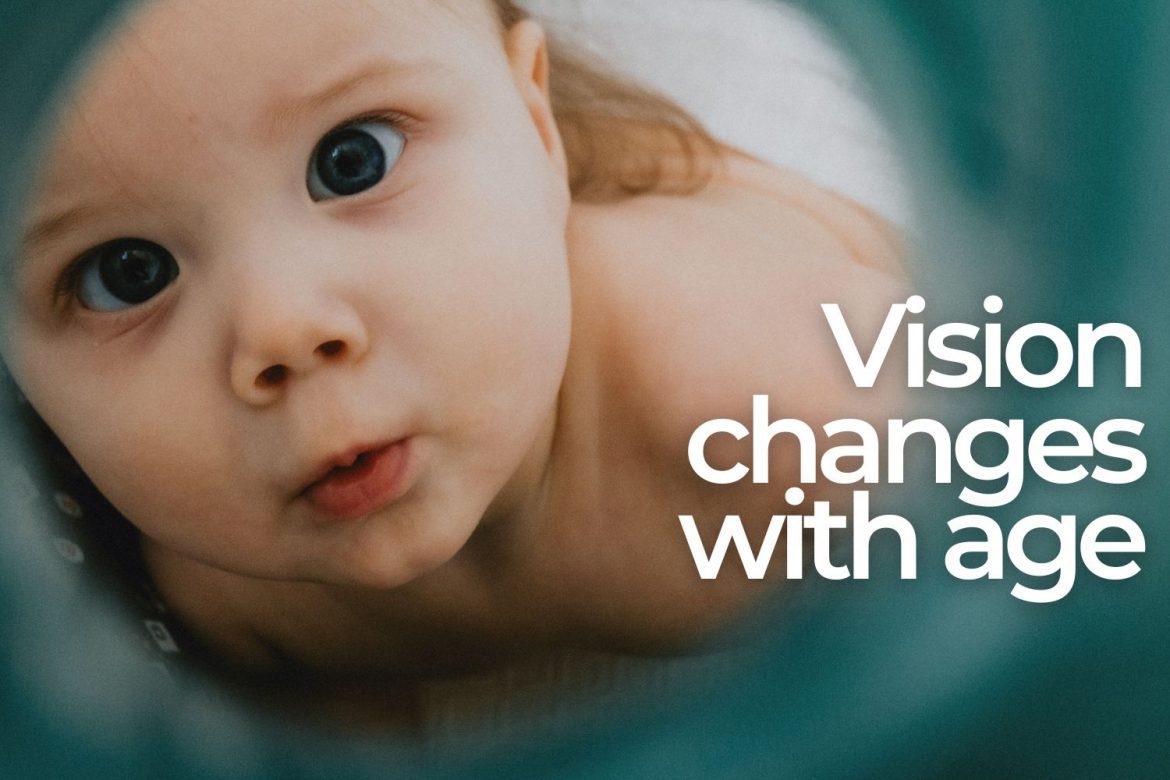
Your eyes cannot escape the hands of time. And so, your vision develops and change over the course of your life.
Considering how much your eyes change throughout your life, it’s important to be aware of key aspects of eye health and vision changes that are specific to each phase of life.
Vision in the early years
Have you ever wondered what a baby sees? Interestingly, vision changes that occur during the first year of life are among the most significant changes that occur over the course of a lifetime.
In the first week, a baby is only able to see black and white, has little sensitivity to light, and has eyes that are just about 70% of their full-grown adult size. The ability to see color slowly starts to develop in the first week to ten days. Newborn babies are also only able to see roughly eight to twelve inches. Distance vision slowly expands with age.
Between two and four months of age, babies develop the ability to follow objects with their eyes—an action commonly referred to as tracking. While the eyes often work independently of each other and may appear crossed at times, the ability to use both eyes (binocular vision) is typically well-developed by month four.
It’s common for eye color to change from blue to brown around month six.
As babies become more mobile between months seven and twelve, the eyes continue to develop depth perception and hand-eye coordination.
Signs of eye and vision issues in infants
Eye and vision issues in infants are rare. While an infant does not have the ability to verbally communicate visual discomfort, there are common signs that are indicative of eye or vision problems:
- Excessive tearing
- Different size pupils
- White spot(s) in the pupil
- Keeping one eye closed
- Red, encrusted eyelids
- Extreme sensitivity to light
Your pediatrician should examine these issues, and if required, make a referral to a pediatric eye doctor for further evaluation.
Vision in childhood and adolescent years
Children’s vision develops to nearly 20/20 around four to five years of age. Early childhood is also the time it’s most common to first notice potential eye health issues.
In fact, according to The American Public Health Organization, an estimated 20% of preschool children experience some type of vision problem. The most commonly observed vision problems among this age group include amblyopia (lazy eye), strabismus (crossed eyes), nearsightedness, farsightedness, astigmatism, and genetic or developmental abnormalities.
While these eye conditions are concerning, it’s important to realize most are treatable when identified and corrected early. Other conditions, including refractory issues, may be easily addressed with prescription glasses.
It’s also important to point out that children are extremely resilient and easily able to adapt to a number of eye and vision issues, making it more difficult for you to tell if there could be an issue.
As children grow and mature, it’s also quite common for vision to change or worsen.
Considering this, eye health experts recommend children have a complete pediatric eye exam at age three and then a comprehensive eye exam at least every two years thereafter.
Vision in adulthood (age 20 to 50)
As you move from your 20s and 30s and approach your 40s, the lens, and muscles of the eyes begin to change. Specifically, the lens of your eye starts to slowly harden and the muscles begin to weaken.
Over time, usually in your late 30s and early 40s, gradual hardening of the lens contributes to presbyopia, an age-related condition characterized by gradual loss of the eye’s ability to focus on nearby objects—even if you’ve had perfect vision your entire life. Symptoms of presbyopia will most likely become progressively worse with age and will often require stronger readers or prescription glasses, contact lenses, or LASIK surgery to offset the effects.
Your eye health and vision, both in early adulthood and later in life, are also impacted by the lifestyle choices you make as an adult. Smoking, excessive consumption of alcohol, being overweight, high blood pressure, and diabetes significantly impact the risk of serious eye health conditions, including cataracts, macular degeneration, and glaucoma.
Eye health and vision after 50
As you age, your eyes continue to change, making it more likely you’ll notice subtle vision changes. As you reach age 50 and beyond, you’re much more likely to experience a number of age-related vision symptoms, including:
- Decreased night vision and issues seeing clearly while driving at night
- Development of floaters or spots in your field of vision
- Increased sensitivity to light and especially glare or reflection
- Progressive loss of peripheral vision
- Loss of color perception
- Decreased tear production and increased incidence of dry eye
In addition to these naturally occurring, age-related vision changes, your risk of developing a number of eye diseases and conditions—including age-related macular degeneration, diabetic glaucoma, cataracts, blepharitis, and retinal detachment—continues to increase.
Approximately one in three elderly people will experience some type of vision reduction or eye disease by age 65.
The American Academy of Family Physicians
While you can’t turn back the hands of time, there are several important steps you can take to protect your eyes and support the health of your vision as you age, including:
- Collecting and sharing a family health history with your primary care physician and your eye doctor
- Maintaining a healthy weight, exercising on a regular basis, and avoiding smoking
- Immediately reporting any sudden vision changes, including pain, flashes of light, blurring, or distortion to your eye doctor
Most healthy adults under the age of 65 should have an eye exam every two to three years or as recommended. Because the increased risk of serious eye issues is greater for those over 65, doctors recommend annual comprehensive eye exams to ensure vision and eye health are being monitored and any issues are being appropriately addressed.

